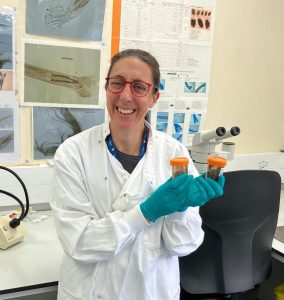Research by Animal and Plant Health Agency (APHA) veterinary investigation officer Natalie Jewell for her MSc project, set out to discover which roundworms are affecting young cattle in the UK and if wormer resistance is on the increase.
This research project aimed to improve the understanding of gastrointestinal nematode species infecting first grazing season cattle in England and Wales, and the genetic susceptibility of these worm populations to benzimidazole (BZ) wormers.
Gastrointestinal nematode infections are a common cause of production loss and disease in young grazing cattle, estimated to cost the UK cattle industry £74m per year. Mixed infections are common and Ostertagia ostertagi and Cooperia oncophora are believed to predominate. Faecal egg counting (FEC) is widely used for diagnosis but is unable to differentiate between roundworm species due to similarities in egg size and shape, contributing to a lack of up-to-date information on species composition.
Anthelmintic resistance is an emerging issue for the UK cattle industry. Use of macrocyclic lactones (MLs) such as ivermectin, has been widespread in the UK and unsurprisingly resistance to this class was confirmed first. More recently, benzimidazole (BZ) resistance was confirmed in O. ostertagi in a UK herd, although it is not known how widespread this is.
One recognised mechanism for BZ resistance in roundworms is genetic mutation at one or more specific positions of a gene that is required for several critical cell functions in the roundworm. These mutated gene forms can be detected by molecular diagnostic techniques.
The project aimed to address these two knowledge gaps using next generation sequencing of gastrointestinal nematode populations obtained from first grazing season cattle in England and Wales during the 2022 and 2023 grazing seasons.
Submissions of dung samples were received from 60 herds in 23 counties, reflecting the national distribution of cattle herds with youngstock. Samples were submitted from multiple management groups in four herds, giving a total of 69 roundworm populations. Most submissions were from weaned cattle with ages ranging from 4 to 18 months. Beef and dairy herd types were represented.
Key findings
Ostertagi and C. oncophora predominated but generalist species Trichostrongylus axei and Haemonchus contortus were also detected in 35% and 28% of herds. The large intestinal nodule worm Oesophagostomum radiatum was detected in 26% of herds, all in the south and west of England and Wales. One or more sheep-associated species were detected in 44% of herds.
BZ resistant genotypes were detected in O. ostertagi in 10% of herds. These were detected in both beef and dairy herds and in all regions of England and Wales.
The frequency of resistant genotypes was often high, raising the possibility of clinical treatment failure occurring, especially if resistance was present in a predominant roundworm species such as O.ostertagi.
The detection of BZ resistant genotypes in 18% of herds, and in several roundworm species, is concerning. Their detection in O. ostertagi highlights that, despite relatively low use of the BZ class by UK cattle farmers, resistance in this pathogenic species is present in the UK and in some cases at high frequency.
Increased future use of BZ products, for example as macrocyclic lactone (ML) resistance becomes a greater problem, could select for increased prevalence of resistance, likely leading to increased incidence of treatment failure on farm.
Limitations of the project, such as the relatively small sample size and the sampling method, mean the results cannot be generalised to the whole UK cattle population or used to estimate national prevalence. However, they do highlight that BZ resistance is more widespread than previously documented.
Opportunities
The findings indicate the development of BZ resistance is at a relatively early stage in cattle roundworms in the UK. This provides opportunities to tackle the problem before it reaches levels seen in the UK sheep flock.
Resistance may arise in roundworms present in a herd following selective pressure applied by the use of worming drugs. Resistant roundworms may also be introduced to the herd by purchased animals or by contact with other groups of grazing ruminants, including both cattle and sheep. This contact may be direct or indirect, for example due to shared pasture either currently or in the past.
Control efforts should therefore focus on improved adoption of sustainable parasite control strategies such as those promoted by the Control of Worms Sustainably (COWS) group, and on effective biosecurity to reduce transmission of resistant roundworms between farms.
Registered Animal Medicines Advisers (RAMAs) and SQPs can help farmers by discussing their individual situations before prescribing or supplying worming products to them, to make sure they are carrying out appropriate roundworm control that is suitable for their particular farm and herd of animals.
I am extremely grateful to the 60 cattle farmers across England and Wales who contributed d ung samples to the project via their veterinary surgeons: without their support, this research would not have been possible. The results have been presented to the British Cattle Veterinary Association (BCVA), and to the COWS steering group. The project data is also feeding into a larger UK-wide research project.
ung samples to the project via their veterinary surgeons: without their support, this research would not have been possible. The results have been presented to the British Cattle Veterinary Association (BCVA), and to the COWS steering group. The project data is also feeding into a larger UK-wide research project.
This research was funded by the APHA’s Scanning Surveillance for Diseases of Cattle in England and Wales (ED100) project funded by DEFRA and the Welsh Government. The assistance of the parasitology teams at APHA Carmarthen and Moredun Research Institute is gratefully acknowledged.